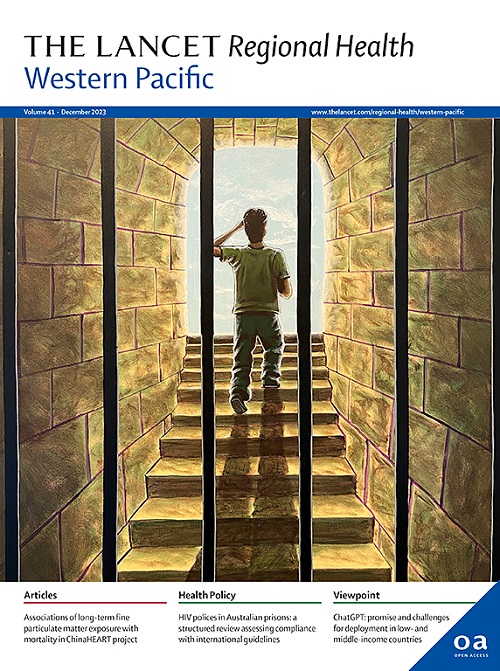中国公众对抗生素的理解和滥用:来自一项综合全国调查的见解
IF 8.1
1区 医学
Q1 HEALTH CARE SCIENCES & SERVICES
引用次数: 0
摘要
抗生素耐药性(AMR)是一个主要的全球健康威胁,抗生素滥用是一个关键驱动因素。本研究评估了中国公众对抗生素的理解和滥用情况,为有针对性的干预措施提供信息。方法数据来源于《中国居民心理与行为调查》(2024年),共有25,047名18岁以上的调查对象。该研究使用经过验证的电子健康素养量表评估抗生素知识、使用实践和相关因素。在25,047名应答者中,59.1%(14,806/25,047)报告听说过抗生素,其中34.8%(5154/14,806)正确识别抗生素的功能。在抗生素使用方面,49.3%(7292/ 14806)报告至少一次未经处方购买抗生素;36.8%(5454/ 14806)未遵医嘱,15.1%(2235/ 14806)自行停药,9.4%(1391/ 14806)调整剂量,16.6%(2457/ 14806)在治疗过程中症状消失后立即停药。女性(OR = 0.843, 95% CI: 0.790-0.900)、少数民族(OR = 0.786, 95% CI: 0.674-0.917)和农村受访者(OR = 0.812, 95% CI: 0.743-0.887)对抗生素正确知识的了解程度较低。少数民族受访者和有孩子的受访者更有可能在没有处方的情况下购买抗生素,而没有伴侣动物的受访者(OR = 0.680, 95% CI: 0.631-0.733)购买抗生素的可能性较小。受过高等教育的受访者不太可能遵循药物指导(OR = 0.848, 95% CI: 0.765-0.941),有儿童或伴侣动物的受访者也是如此。中国公众对抗生素的了解和使用未达到国家目标。该研究揭示了人口因素与抗生素使用之间的复杂关系,表明需要有针对性的干预措施来有效解决抗生素耐药性问题。基金资助:国家自然科学基金(NO. 5);国家卫生健康委卫生经济与政策研究重点实验室(NO. 72474119);NHC-HEPR202401)。本文章由计算机程序翻译,如有差异,请以英文原文为准。
Public understanding and misuse of antibiotics in China: insights from a comprehensive national survey
Background
Antimicrobial resistance (AMR) is a major global health threat, with antibiotic misuse as a key driver. This study assessed public understanding and misuse of antibiotics in China to inform targeted interventions.
Methods
Data were extracted from the Psychology and Behaviour Investigation of Chinese Residents (2024), including 25,047 respondents over the age of 18 years. The study evaluated antibiotic knowledge, use practices, and associated factors using validated electronic health literacy scales.
Findings
Of the 25,047 respondents, 59.1% (14,806/25,047) reported having heard about antibiotics, with 34.8% (5154/14,806) correctly identifying their function. Regarding antibiotic use, 49.3% (7292/14,806) reported purchasing antibiotics without prescription at least once; 36.8% (5454/14,806) did not follow physicians’ instructions specifically, 15.1% (2235/14,806) discontinued their medication independently, 9.4% (1391/14,806) adjusted their doses, and 16.6% (2457/14,806) stopped taking the antibiotic immediately after their symptoms disappeared during the treatment. Female (OR = 0.843, 95% CI: 0.790–0.900), minority (OR = 0.786, 95% CI: 0.674–0.917) and rural respondents (OR = 0.812, 95% CI: 0.743–0.887) were less likely to have a correct knowledge of antibiotics. Minority respondents and those with children were likelier to purchase antibiotics without prescription, whereas those without companion animals (OR = 0.680, 95% CI: 0.631–0.733) were less so. Higher educated respondents were less likely to follow medication instructions (OR = 0.848, 95% CI: 0.765–0.941), so were those with children or companion animals.
Interpretation
Public understanding and use of antibiotics in China fall short of national targets. The study reveals complex relationships between demographic factors and antibiotic practices, suggesting the need for targeted interventions to address AMR effectively.
Funding
This work was supported by the National Natural Science Foundation of China (NO. 72474119) and National Health Commission Key Lab of Health Economics and Policy Research (NO. NHC-HEPR202401).
求助全文
通过发布文献求助,成功后即可免费获取论文全文。
去求助
来源期刊

The Lancet Regional Health: Western Pacific
Medicine-Pediatrics, Perinatology and Child Health
CiteScore
8.80
自引率
2.80%
发文量
305
审稿时长
11 weeks
期刊介绍:
The Lancet Regional Health – Western Pacific, a gold open access journal, is an integral part of The Lancet's global initiative advocating for healthcare quality and access worldwide. It aims to advance clinical practice and health policy in the Western Pacific region, contributing to enhanced health outcomes. The journal publishes high-quality original research shedding light on clinical practice and health policy in the region. It also includes reviews, commentaries, and opinion pieces covering diverse regional health topics, such as infectious diseases, non-communicable diseases, child and adolescent health, maternal and reproductive health, aging health, mental health, the health workforce and systems, and health policy.
 求助内容:
求助内容: 应助结果提醒方式:
应助结果提醒方式:


